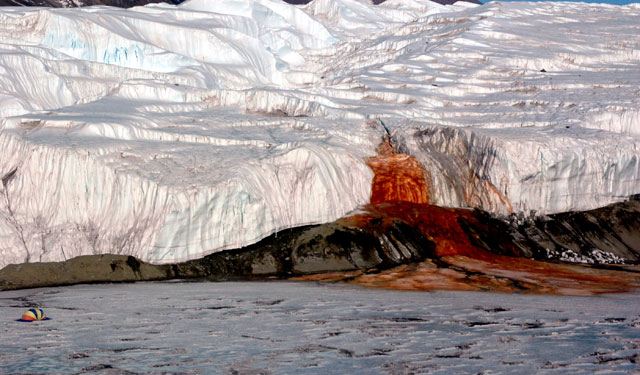|
Environmental precedentBlood Falls becomes first subglacial ASPA to protect scientific valuesPosted August 31, 2012
Blood Falls The red-stained “falls” are found at the terminus of the Taylor Glacier, pouring out onto the ice-covered surface of Lake Bonney in the McMurdo Dry Valleys The subglacial ecosystem is home to a unique microbial community that scientists believe has evolved over hundreds of thousands of years to subsist on a chemical soup of sulfur and iron compounds in the absence of oxygen and light. It’s the sort of conditions that might exist on another planet or moon, making it a valuable natural laboratory to study exobiology. That laboratory became the first sub-aerial Antarctic Specially Protected Area (ASPA) “It was a new type of concept. What you have is a three-dimensional protected area,” explained Nate Biletnikoff, Environmental, Health and Safety manager for the U.S. Antarctic Program (USAP) “It’s deemed as something unique,” he added. The nations that manage the southernmost region under the Antarctic Treaty System formally adopted the Lower Taylor Glacier and Blood Falls ASPA based on a U.S. proposal submitted this summer during their annual meeting, held this year in Hobart, Australia. It became the 72nd ASPA, one of 14 put forth by the United States over the years. An ASPA protects outstanding environmental, scientific, historic, aesthetic or wilderness values, or a combination of those values, or ongoing or planned scientific research. A permit is required to enter an ASPA. In the case of Blood Falls, the ASPA defines the boundaries of the protected area both below and above the glacier surface, where scientists also work on research ranging from glaciology to paleoclimatology. “The ASPA designation for Blood Falls will help ensure that we are all mindful of the unique, interdisciplinary values of this system when planning and executing our research at this fascinating feature,” said Jill Mikucki “We still have a lot to learn from Blood Falls, but I think we need to always be conscience of the potential environmental impacts of our science,” she added. “It is an important balance between understanding and impact.” The ASPA boundary includes an unprecedented and extensive subsurface region that extends 50 kilometers up the glacier, with the goal of protecting the subglacial catchment of the lower Taylor Glacier that could be connected with the brine reservoir. Colin Harris, director of Environmental Research & Assessment (ERA) “We recognized that the brine reservoir is currently not well-defined, so we decided that a precautionary approach to boundary design was needed, and this led to defining an extensive horizontal boundary around the primary catchment area feeding into the reservoir location,” he said via email. A natural “cut-off” was agreed upon at Beehive Mountain in Kennar Valley. Harris said more than 60 researchers were consulted in the development of the ASPA plan. They concluded that activities at the surface of the glacier probably wouldn’t affect the subglacial environment, so no permits are required for research up to 100 meters below the top of Taylor Glacier. “This approach ensures that activities at the surface are not unnecessarily constrained, and focuses the need for permits on activities that have more potential to compromise the values we are aiming to protect,” explained Harris, who has worked in environmental management for more than 20 years and has been involved in the development of numerous ASPA plans for the United States and other nations. |



For USAP Participants |
For The Public |
For Researchers and EducatorsContact UsNational Science FoundationOffice of Polar Programs Geosciences Directorate 2415 Eisenhower Avenue, Suite W7100 Alexandria, VA 22314 Sign up for the NSF Office of Polar Programs newsletter and events. Feedback Form |



